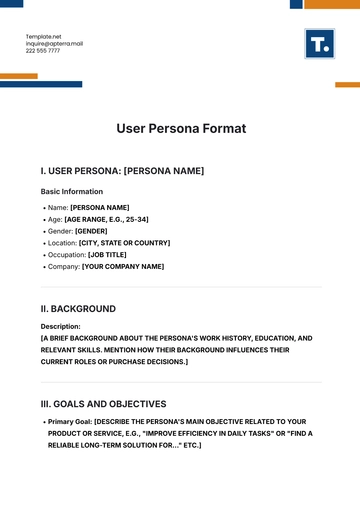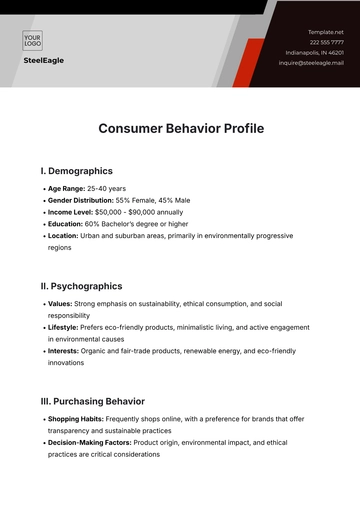Free Premium Managed Services Customer Profile

I. Client Overview
This section provides a comprehensive overview of [Client Company Name], a leading global technology company specializing in software development and IT solutions.

1. Company Background
Company Name: [Client Company Name]
Industry: Technology
Years in Operation: 25 years
Key Competitors: [Client Key Competitors]
Unique Selling Points: [Client Company Name] is known for its cutting-edge solutions, exceptional customer service, and commitment to innovation.
2. Service Requirements
Scope of Services: Managed IT services, cybersecurity solutions, and cloud migration support.
Customization Level: High level of customization to meet specific business needs.
Preferred SLAs: 99.99% uptime, rapid response times for critical incidents.
Performance Benchmarks: Increase system efficiency by 20%, and reduce security incidents by 30%.
Budget Parameters: Annual budget of $5 million for premium managed services.
Strategic Goals: Enhance cybersecurity posture, and optimize IT infrastructure for scalability and performance.
II. Current Challenges and Pain Points
Determine the specific challenges and pain points currently faced by the client that demonstrate the necessity for investing in premium managed services.
1. Operational Challenges
Inefficient legacy systems cause productivity bottlenecks.
Lack of centralized IT management leads to coordination issues.
Compliance requirements becoming increasingly complex.
2. Technological Pain Points
Vulnerability to cyber threats due to outdated security measures.
Difficulty in scaling infrastructure to meet growing business demands.
Limited visibility and control over cloud-based assets.
III. Desired Outcomes
Specify the client's desired outcomes and expectations from the engagement with [Your Company Name].
1. Business Objectives
Streamline IT operations to improve overall efficiency.
Strengthen cybersecurity defenses to mitigate risks.
Achieve cost savings through optimized resource utilization.
2. Performance Expectations
Reduce system downtime by 50% within the first six months.
Enhance data security measures to achieve full compliance with industry standards.
Increase employee productivity by providing reliable IT support services.
IV. Success Criteria
Define the measurable success criteria that will indicate the effectiveness of the premium managed services provided by [Your Company Name].
1. Key Performance Indicators (KPIs)
KPI 1: Achieve 99.9% uptime for critical systems by June 1, 2050.
KPI 2: Reduce mean time to resolution (MTTR) for IT incidents to less than 30 minutes by December 31, 2050.
KPI 3: Improve cybersecurity posture to achieve zero security breaches by December 31, 2050.
2. Milestones
Milestone 1: Complete infrastructure assessment and optimization by July 15, 2050.
Milestone 2: Implement an advanced threat detection and response system by September 30, 2050.
Milestone 3: Conduct comprehensive staff training on cybersecurity best practices by November 15, 2050.
V. Additional Information
Include any additional relevant information that could impact the delivery of premium managed services.
1. Regulatory Compliance
Strict adherence to industry regulations such as GDPR and HIPAA.
Regular audits and assessments to ensure compliance with data protection laws.
2. Internal Stakeholders
Key Decision Makers: [CEO's Name] (CEO), [CIO's Name] (CIO), [CTO's Name] (CTO).
Project Champions: IT Operations Manager, Chief Information Security Officer (CISO).
3. External Partnerships
Existing Partnerships: [Existing partnerships]
Desired Partnerships: Collaboration with leading cybersecurity firms for threat intelligence sharing.
VI. Next Steps
Outline the proposed next steps for further discussion and engagement with [Client Company Name].
Step 1: Schedule a kickoff meeting to discuss a detailed project plan and timelines by June 15, 2050.
Step 2: Conduct an onsite assessment of the current IT infrastructure by July 1, 2050.
Prepared By :
[YOUR NAME]
Company:
[YOUR COMPANY NAME]
Email :
[YOUR COMPANY EMAIL]
Date Prepared :
[DATE]
- 100% Customizable, free editor
- Access 1 Million+ Templates, photo’s & graphics
- Download or share as a template
- Click and replace photos, graphics, text, backgrounds
- Resize, crop, AI write & more
- Access advanced editor
Discover the Premium Managed Services Customer Profile on Template.net. Tailor-made for excellence, this template offers editable, customizable features to suit your business. Effortlessly refine client profiles with our Ai Editor Tool, ensuring every detail reflects your professionalism. Elevate your managed services with ease and sophistication, revolutionizing client experiences and setting new standards in the industry.





























